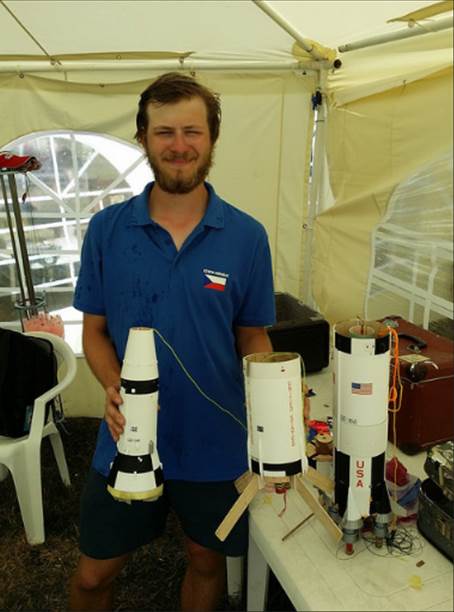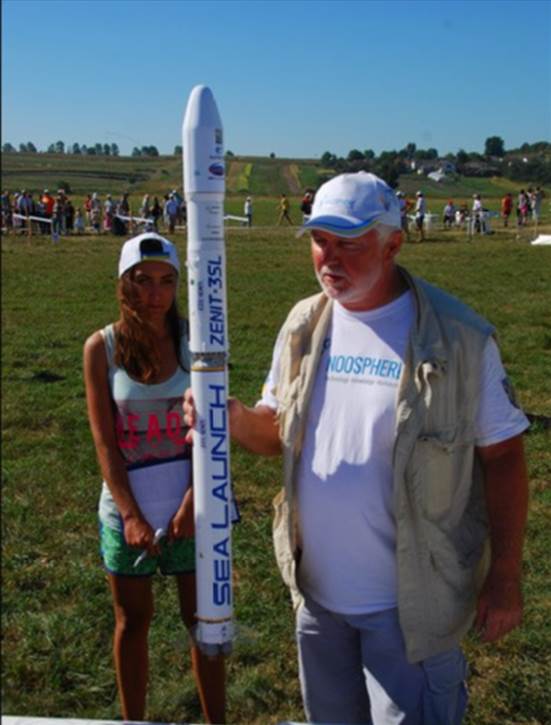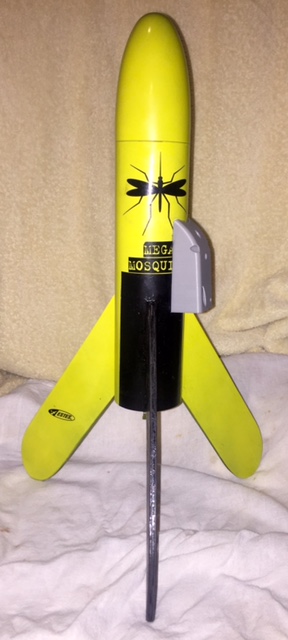More highlight pictures and video from the terrific day :
Rocketry is a fun and educational hobby!
National Geographic video on Rockets
JONNY PHILLIPS Of all the different methods of propulsion invented by mankind, for pure, unadulterated, heart stopping excitement nothing really compares to rockets.
RICHARD AMBROSE: OK – I am about to initiate the launch sequence. Now stand right back and witness the explosive power of rocketry. Whoa!
JONNY PHILLIPS (SYNC – TO RICHARD): Um – I think we’re gonna need bigger rockets, don’t you?
NARRATOR: Well boys, how about the biggest rocket of all time? Imagine 50 jumbo jets at full power, strapped to a 36 storey building. That’s Saturn 5.
It takes something like this to catapult man to the moon. But where does the colossal thrust actually come from?
RICHARD AMBROSE (PTC): Inside a rocket motor fuel is turned into gas through combustion and the gas is then forced out the back. And the reason why escaping gas pushes a rocket forward is explained by Newton’s Third Law of Motion.
JONNY PHILLIPS (PTC): Which is, as I’m sure you’ll remember from school, that every action has an equal and opposite reaction.
RICHARD AMBROSE (PTC): That’s the theory but what we need is a practical demonstration. Now as Jonny opens the valve on this pressurized gas canister the air will rush out but at the same time an equal and opposite force will propel it this way. Go on Jonny – open it up.
JONNY PHILLIPS (PTC): So there you have it. The basics of rocketry. Well what did you expect? It’s not rocket science.
NARRATOR: The rocket’s launch speed does not depend on the astronaut flooring the throttle but on how quickly the gas escapes from the exhaust.
Space rocket exhausts are hour glass shaped because gas flows at an accelerated rate if it’s forced through a narrow section into a wider end.
NARRATOR: The exhaust is crucial no matter what the size of the rocket.
Here is a great video clip of Daniels Pershing 1A from The Launch Pad on an Aerotech 24mm reload motor.
https://www.facebook.com/hoodriverhobbies/?fref=nf
Veteran satellite industry analyst Chris Quilty says SpaceX could be looking at a six-month stand down if its accident investigation reveals that internal tankage or plumbing on the Falcon caused the Sept. 1 pre-flight failure.
When I was deployed in Iraq of 2005 I was given a book from the editor of Quest magazine. This was a true gem because it was the only endorsed biography from Neil Armstrong:
https://www.facebook.com/QuestQuarterly/
August 22-27, 2016 Lviv, Ukraine
American World Space Modeling athletes took to the fields of Lviv for the biannual gathering of nations to determine world champions in space modeling. Team USA brings home three individual gold medals, one team gold medal, two individual silver medals, three team silver medals, one individual bronze medal, and one team bronze medal.
The Senior Team USA also placed third overall at the competition to score bronze. What an outstanding accomplishment for all who participated.
The USA final podium results are:
S2P (Precision fragile payload) World Cup –
Sr. Individual Gold – Emma Kristal
Sr. Team Gold – USA
Jr. Individual Silver – Ashley VanMilligan
Jr. Individual Bronze – Allison VanMilligan
Jr. Team Silver – USA
S1A Altitude (Junior) –
Individual Silver – Ashley VanMilligan
Team Silver – USA
S1B Altitude (Senior) –
Individual Gold – Dr. Bob Kreutz
Team Silver – USA
S5C Scale Altitude (Senior) –
Individual Gold – Matt Steele
S8D R/C R/G (Junior) –
Team Bronze – USA
Congratulations to all of the team members, supporters, and captain John Langford for this awesome showing at the international competition.
Noosphere did a terrific job promoting the 2016 WSMC event. This YouTube video highlights some very impressive flights:
Final Days event ended with Scale Model Competition for Senior and Junior Division.

The Individual Senior competitor from the Czech Republic, Jan Sebesta submitted a scale model of the Saturn V . The static scoring points were 516 for static display. He was one point shy in the static scoring against the Ukraine Mykoia Pushkar who entered a scale model of the Zenit 3SL rocket who had a static score of 517. Jan’s Saturn V rocket had a successful first launch that gave him a score of 240 (Total points 756). Mykoia had a DQ on his first attempt. The second flight attempt was successful, however he only

gained 236 points (Total points 753). It was a very very close competition.
Complete results of the days events are here:
Final results of the 2016 FAI S World Championship for Space Models

The little E 22 CTI 24mm 1-grain reload worked perfectly with a 5 second delay. The camera is the keychain digital camer model 808 #16 model. The holder is a 3D printed shroud that can be easily attached to a 2.0 inch diameter body tube.
The web link is: http://additive-aerospace.myshopify.com/collections/video-camera-shrouds/products/808-16-camera-shroud
and the creator is Andrew Diehl. He can be contacted at Andrew@AdditiveAerospace.com